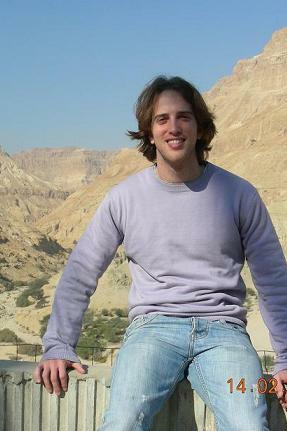Davidovitch, Dotan
PhD student

- dotandav@post.bgu.ac.il
Education
-
2012-
2015,
PhD
Physical forces in the organisation of Bacterial nucleoid
with Oleg KrichevskyAbstract/Description: Genomic DNA in Escherichia coli nucleoid has an overall length of more than 1.6 mm while occupying the space of only 1 micrometer cubed in size. Nucleoid compaction poses a set of physical and biological questions. What are the forces causing nucleoid compaction? How nucleoid organization allows it to be that compact and still active in gene transcription and DNA replication? How nucleoid structure is regulated at different stages of cell cycle and different rates of growth? Several factors have been proposed in the literature that lead to nucleoid condensation: DNA superhelicity, macromolecular crowding and nucleoid binding proteins. However, the relative effects of these factors on nucleoid structure are not clear. Currently there is no good method to resolve nucleoid structure: imaging studies do not have sufficient resolution while other approaches are informative yet indirect. There has been no methods allowing to measure the stucture factor of the nucleoid - one of the basic structural characteristics of the soft matter system. Here we propose to apply to nucleoids the method recently developed in our lab for the measurement of the structure of DNA solutions. The method is based on fluorescence labeling of DNA with the help of dyes or DNA-binding proteins coupled with Scanning Fluorescence Correlation Spectorscopy (SFCS) monitoring of spatial fluctuations in fluorescence. We will further increase the resolution of the method by coupling it to an optical super-resolution technique (Stimulated Emission Depletion microscopy - STED) and we will introduce the microfluidic manipulation of bacterial cell and nucleoid. We will use these technical advance to measure nucleoid structure in vitro and in vivo in a variety of conditions (varying DNA superhelicity, the concentrations of crowding agents as well as of multi- and mono- valent electrolytes, bacterial growth conditions etc). Currently, we have constructed STED-SFCS setup that allows us to reach resolution of 70 nm and we successfully isolated nucleoids under a microfluidics chip. These are the major technical steps in achieving the goals of my research.
-
2011-
2012,
MSc
Adiabatic and Non-adiabatic Transport in Networks
with Doron CohenAbstract/Description: A shuttle site that crosses through a band of network levels induces currents. If the process is re-cycled this can be regard as "pumping" or "stirring". In the first part of the thesis we calculate the average current that is induced in an N~site clean ring, as a result of an applied electric pulse. We assume that there is no magnetic field present,
hence the Hamiltonian is time reversal invariant at any moment. A closed expression for the average current in leading order of perturbation theory is obtained. An exact analysis of a Rabi-type ignition protocol is also considered.In the second part of the thesis our interest is in the current that is induced in a 3~site ring during the variation of the potential at one distinguished site. We call the distinguished site ``shuttle" and denote its potential energy by~u. It is assumed that u is varied from -infinity to +infinity with rate du/dt.We are interested in the current I(t) through a given bond. Both the adiabatic and the non-adiabatic regimes are addressed. In the adiabatic regime we analyze how~I changes with u(t)
and distinguish various regimes, depending on the ratio between the inter and intra shuttle-network couplings. We provide an exact solution, as well as approximations that are based on a 2~level phenomenology. In this context we highlight a prototype process that we call "adiabatic metamorphosis".In the third part of the thesis we consider a general N~site random network. As a result of a shuttling process, the particle is distributed in space over the different levels of the network. The focus is on the statistics of the integrated currents that flow through the bonds of the network during the variation of the shuttle potential. We find that the statistics of the maximal integrated current changes from power-law to Gaussian as du/dt is increased.